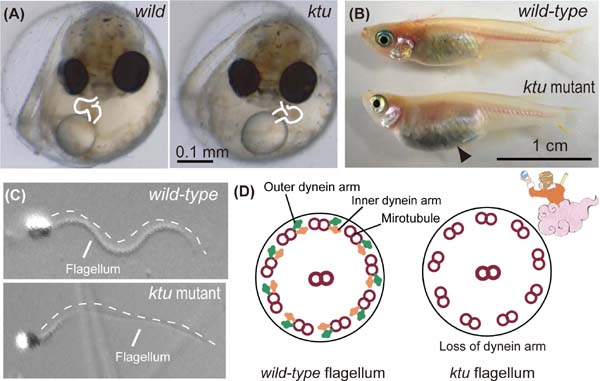From a medaka LR mutant to primary ciliary dyskinesia - A novel gene required for cytoplasmic pre-assembly of axonemal dyneins
Cilia play diverse roles in cell motility, fluid transport and patterning embryos, and thus have been linked to a variety of diseases such as primary ciliary dyskinesia (PCD). However, the mechanisms underlying cilia formation, in particular the cytoplasmic processes involved in dynein arm assembly, are only poorly understood.
The medaka mutant kintoun (ktu) was originally isolated as a LR randomization mutant, and found to be defective in ciliary/flagellar motility (Fig. A, C). Interestingly, ktu homozygous adult fish develops polycytic kidney disease, because of which the belly of the mutant becomes expanded (Fig. B, arrowhead). By positional cloning, we found that the ktu gene encodes a novel cytoplasmic protein conserved from ciliated unicellular organisms to higher mammals. Furthermore, we have identified mutations in the homologous gene of two human PCD families and in pf13, a Chlamodomonas mutant with paralyzed flagella. In all affected organisms the cilia develop normally but exhibit complete or partial loss of outer and inner dynein arms (Fig. D), leading to loss of motility. Based on our data, we propose that Ktu is one of the long sought-after proteins required in the cytoplasm for pre-assembly of dynein arm complexes.Program member
Hiroyuki Takeda (Department of Biological Sciences, Graduate School of Science)
Ritsu Kamiya (Department of Biological Sciences, Graduate School of Medicine)
Yoshinori Watanabe (Institute of Molecular and Cellular Biosciences)

Figure:PCD-like phenotypes of medaka ktu mutant. (A) The heart (outlined) of wild-type and ktu embryos at 3 days postfertilization. (B) External appearance of wild-type and ktu adult fish (3-month old). The arrowhead indicates the expanded belly. (C) Snapshots of high-speed videos of swimming sperm from wild-type and ktu adults, showing a defective beating pattern in mutant sperm. (D) Schematic illustrations of cross section of flagella from wild-type and ktu sperm. In the absence of Ktu, both outer and inner dynein arms are missing or defective in the axoneme, leading to a loss of motility.
